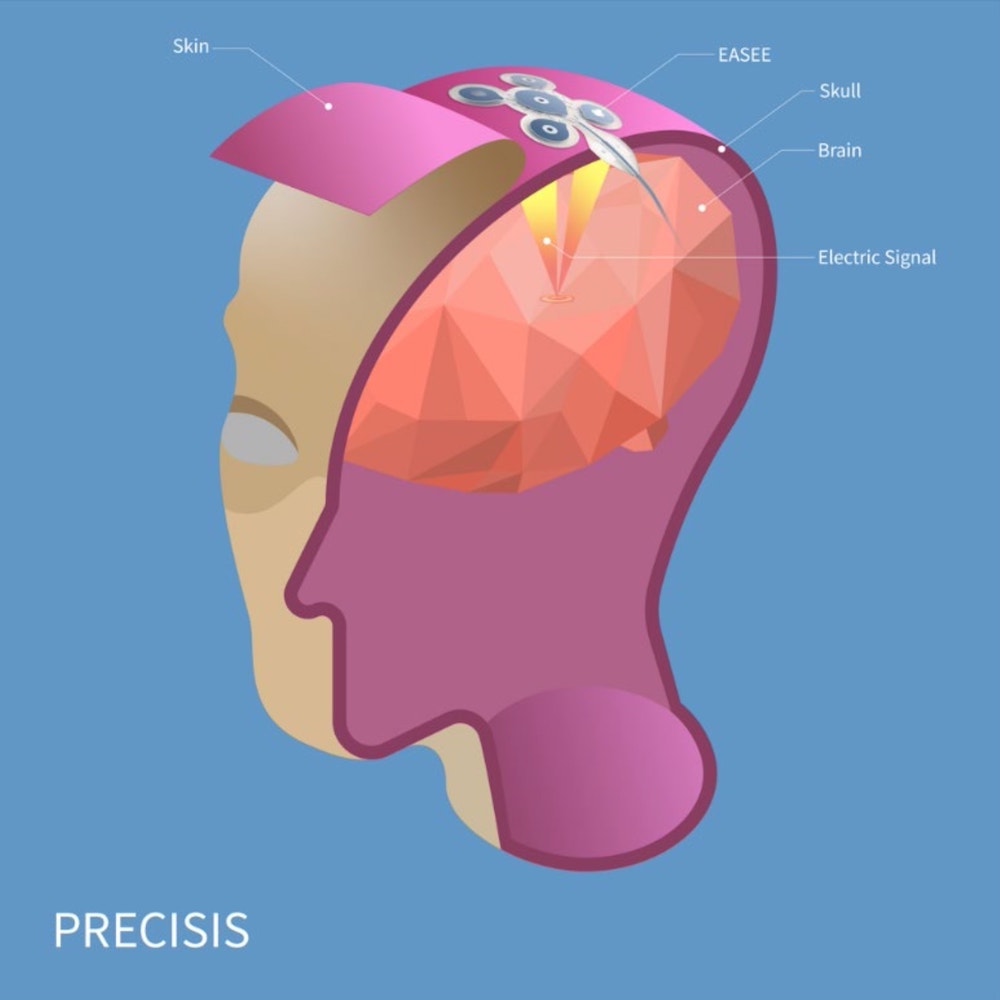EASEE® – World's first minimally invasive brain pacemaker for the treatment of epilepsy receives CE-certification and is available immediately
Heidelberg, 23.09.2022 – after seven years of development work, Precisis GmbH, headquartered in Heidelberg, has received the CE certification for its minimally invasive brain pacemaker EASEE®. The thin EASEE® electrodes are placed under the scalp and send bioelectric pulses to the location in the brain where the epileptic seizures originate from. The safety and effectiveness of the implant have been proven in two European multi-center studies. The regulatory process was conducted according to the current MDR requirements (Medical Device Regulation). From now on, patients who suffer from drug-refractory focal epilepsies have now a new technological therapy option.
Prof. Christian Elger, MD, Medical director and managing partner of the Beta Neurologie Bonn – Center of Excellence for Epilepsy, describes the problem: "The treatment of patients with epilepsy always begins with medication. However, for decades there has unfortunately been a consistently large group of around 30% of all patients for whom pharmacological treatment is not sufficiently effective. These drug-refractory patients wait an average of 22 years before they are offered further technical or surgical treatment options. With this new, risk-minimized EASEE® method, the treatment spectrum is expanded in the early phases of the disease."
About EASEE®
EASEE® is an acronym for Epicranial Application of Stimulation Electrodes for Epilepsy. It is a system for individualized brain stimulation, which is placed anatomically precisely over the epileptic origin in the brain but is surgically placed only under the scalp. This means that the cranial bone is not opened, and the brain itself remains untouched. EASEE® is based on a dual principle of action. Prof. Michael Nitsche, MD, Scientific Director, Dept. Psychology and Neurosciences Leibniz Research Centre for Working Environment and Human Factors, Dortmund, describes the effect as follows: "EASEE® has a disruptive, acute effect with high-frequency pulses every two seconds against emerging seizures. On the other hand, direct current-like phases that are applied once a day for 20 minutes offer preventive effects that regulate over-excitable brain areas in the long term."
The thin plane electrodes are not visible from the outside and ensure unrestricted freedom of movement for the patient. The therapeutic pulses can be individually adapted to each patient, and optimizations can be made regularly throughout the duration of the treatment; the patients do not feel the stimulations. "We are thrilled that our technological innovation is now ready for the market. Thus, patients with drug-refractory epilepsies have another good chance of relieving the burden of their seizures" says Angela Liedler, MD, Managing Director of Precisis.

Image copyright @Precisis. Reprint free of charge.
The CE mark certifies that EASEE® meets the specified safety and performance requirements. Medical products can only be placed on the European market with a CE mark. Accordingly, EASEE® will be available for adult epilepsy patients with immediate effect. The certification is based on the new Medical Device Regulation (MDR). In contrast to the previously applicable Medical Device Directive (MDD), this means additional reports and extensive technical documentation on the producer's part.
"Despite increased requirements for producers of medical devices, Precisis has managed to bring EASEE® to the market in record time," says Michael Tittelbach, CTO. "This is mainly due to the agility of our team." Only seven years have passed from the idea to approval for EASEE, making EASEE® more than comparable to other products in the same risk class.
The successful approval is based on the data from two clinical studies. "The primary goal of the studies was to demonstrate the system's safety. However, it was particularly interesting for the patients and us, to see the reduction in seizures and to see continued improvement in seizure control." notes Prof. Schulze-Bonhage, MD, Head of Department of the Epilepsy Center at the Neuro center of the University Hospital Freiburg, Head of the Clinical Studies on EASEE®. The data evaluation after six months showed a reduced frequency of seizures of at least 50 percent in 17 of 33 participants. After six months of stimulation, four patients were completely free of seizures. The low-risk implantation procedure and the outstandingly positive spectrum of side effects suggest that EASEE® will be a future therapeutic option for drug-refractory focal epilepsies."
About Precisis GmbH
Precisis GmbH, headquartered in Heidelberg, specializes in developing innovative neurostimulation devices. Our team of 20 heads consists of experienced and entrepreneurial personalities with a common goal: to bring the next generation of intelligent brain pacemakers onto the market to enable patients with functional brain diseases to have a better quality of life. We always work as a team, full steam ahead, because what counts for us are countable successes! The CE certification that has just been obtained is an important milestone; the next one will be the approval in the USA. We all feel like we're doing something meaningful.
Sources
- Fisher R, Salanova V, Witt T, et al. (2010). Electrical stimulation of the anterior nucleus of thalamus for treatment of refractory epilepsy. Epilepsia.51(5):899-908
- Kwan P & Brodie MJ (2000). Early identification of refractory epilepsy. The New England Journal of Medicine. 342:314-319.
- Norman G (2016). Drugs, Devices, and the FDA: Part 2: An Overview of Approval Processes: FDA Approval of Medical devices. JACC: Basic to translational science. 1 (4): 277-287.
- Schulze-Bonhage A, Winter Y, Hirsch M, et al. (2022). Antiepileptische Wirkung fokaler Cortex-Stimulation (FCS) mit dem EASEE-System bei pharmakoresistenter fokaler Epilepsie. DGfE Tagung Leipzig.
- Hirsch M & Schulze-Bonhage A (2022). Motorische Symptome im Anfall können durch eine vom Patienten applizierte iktale transkranielle fokale Cortex-Stimulation (FCS) verhindert werden. Eine Kasuistik. DGfE Tagung Leipzig.
- Winter Y, Groppa S, Schulze-Bonhage A (2022) Effekt der transkraniellen Gleichstromstimulation (tDCS) auf kognitive Leistung von Patienten mit therapierefraktären strukturellen Epilepsien. DGfE Tagung Leipzig.